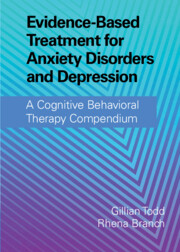 Evidence-Based Treatment for Anxiety Disorders and Depression
Evidence-Based Treatment for Anxiety Disorders and Depression Book contents
- Evidence-Based Treatment for Anxiety Disorders and Depression
- Evidence-Based Treatment for Anxiety Disorders and Depression
- Copyright page
- Contents
- Figures
- Tables
- Contributors
- 1 Introduction
- 2 The History and Philosophical Underpinnings of CBT:
- Part One Cognitive Behavioral Therapy for Anxiety Disorders
- Part Two Cognitive Behavioral Therapy for Posttraumatic Stress Disorder
- Part Three Cognitive Behavioral Therapy for Obsessive-Compulsive Disorder and Associated Disorders
- Part Four Cognitive Behavioral Therapy for Depression
- 18 Behavioral Activation
- 19 CBT for Persistent Depressive Disorder
- 20 Rumination-Focused Cognitive Behavioral Therapy
- 21 Cognitive Behavioral Therapy for Perinatal Depression
- Part Five Complexity and Comorbidity in Anxiety Disorders and Depression:
- Part Six Specialist Applications of Cognitive Behavioral Therapy for Anxiety Disorders and Depression
- Part Seven Future Developments
- Appendices
- Index
- References
20 - Rumination-Focused Cognitive Behavioral Therapy
from Part Four - Cognitive Behavioral Therapy for Depression
Published online by Cambridge University Press: 06 January 2022
- Evidence-Based Treatment for Anxiety Disorders and Depression
- Evidence-Based Treatment for Anxiety Disorders and Depression
- Copyright page
- Contents
- Figures
- Tables
- Contributors
- 1 Introduction
- 2 The History and Philosophical Underpinnings of CBT:
- Part One Cognitive Behavioral Therapy for Anxiety Disorders
- Part Two Cognitive Behavioral Therapy for Posttraumatic Stress Disorder
- Part Three Cognitive Behavioral Therapy for Obsessive-Compulsive Disorder and Associated Disorders
- Part Four Cognitive Behavioral Therapy for Depression
- 18 Behavioral Activation
- 19 CBT for Persistent Depressive Disorder
- 20 Rumination-Focused Cognitive Behavioral Therapy
- 21 Cognitive Behavioral Therapy for Perinatal Depression
- Part Five Complexity and Comorbidity in Anxiety Disorders and Depression:
- Part Six Specialist Applications of Cognitive Behavioral Therapy for Anxiety Disorders and Depression
- Part Seven Future Developments
- Appendices
- Index
- References
Summary
Rumination and worry are characteristic mental processes within depression and anxiety that have been found to contribute to the onset and maintenance of multiple disorders and to interfere with effective recovery. As such, they are important targets for treatment and prevention. Cognitive behavioral therapy (CBT) has been adapted to specifically target rumination and worry, building on experimental research. This rumination-focused CBT has been proven to be efficacious in clinical trials. Rumination-focused CBT is based on the ideas that (1) rumination is a learnt habit and that effective treatment requires recognition of the triggers for the habit and either their removal/interruption or the learning of new adaptive responses to the triggers, based on repeated practice and if-then plans, and that (2) thinking over difficult situations is a normal response that can be helpful or unhelpful, and the therapy works with clients to shift them into a more helpful, concrete (How?) way of thinking rather than an unhelpful, abstract (Why?) way of thinking. The current chapter outlines the key principles, structure, and techniques within rumination-focused CBT including functional analysis, formulation, shifting thinking style, absorption, compassion, how to conduct assessments, how to select treatment components, and how to handle problems.
- Type
- Chapter
- Information
- Evidence-Based Treatment for Anxiety Disorders and DepressionA Cognitive Behavioral Therapy Compendium, pp. 402 - 417Publisher: Cambridge University PressPrint publication year: 2022


